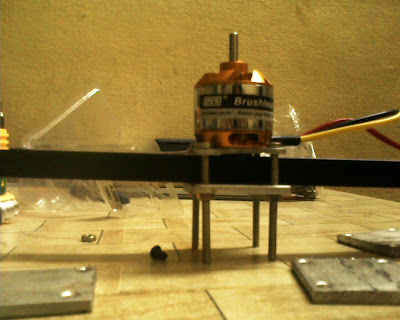
The receiver module of our quadrotor helicopter containing six channels ,i.e. we can transmit and receive six signals simultaneously.The Pwm signals comes out of these receiver module which changes according to the movement of the joystick(analog stick) available in the transmitter.If we move the stick of channel 1 in the transmitter then we get change in the signals of the first channel of the receiver,same is the case with other channels of the receiver.......

Tramsmitter-receiver module.This trasmitter trasmits signals @2.4 Ghz.The range of this trasmitter is more than 100 metres ,cant say more than that because we have checked only upto 100 meters.The range could be much more than that.It is a four channel trasmitter.This transmitter works on GFSK technique with FM modulation.

In the above picture Lokendra Tomar giving power to the receiver module by connecting that to ESC .Receiver is not directly connected to battery because the power requirement of receiver is very less and it is given by inbuilt BEC of the ESC (Electronic speed controller),so ESC is connected to the battery and then receiver is connected to the ESC (for circuit/connection diagram :look @ the previous post typical
connection diagram of receiver and ESC).After the conection one of the channel output of the receiver is given to the input of the CRO.
Lokesh parmar then calibrated the CRO according to the signal we were receiving on the CRO.CRO was self tested by Joshi sir(Lab technician),before we started working.After Changing the time divisions and the amplitude and shifting the wave on CRO,we got the waveform that we were trying to look for.Its an On-off pulse with an maximum voltage of about 3.5 volts and the On(High) timing of the pulse is 20 ms and Off(low) time 4 ms.So the frequency of pulse is approximately 40 Hz..

Look @ the anove pulseon CRO, how smooth and clear it is.Off(low) time in the above pulse is very low but even then you can easily observe that.

On moving the Analog Stick(joystick ) of channel 1 ,the pulses of channel 1 changes.When we move the analog stick upward ,the width of the ON time increase in accordance to the movement of stick,when we move analog stick downward the OFF width of the pulse increases.But the overall width of the pulse remained the same.

we looking @ the varying pulse on moving the analog stick and analysing the signals and calculating the results.

After the whole testing was done we had tea as always ,beacause
"Yaar ab itti testing ke baad ek chai to banti hai.................. "
This whole testing was done in the lab of our college IES-IPS Academy.Sorry but i forgot what was the name of the lab,the only thing we need was a CRO.
Mayank Gupta





















